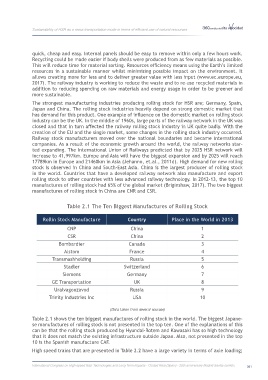Page 393 - 360.revista de Alta Velocidad - Nº 6
P. 393
Sustainability of HSR as a mass transportation mode in terms of efficient use of natural resources
quick, cheap and easy. Internal panels should be easy to remove within only a few hours work.
Recycling could be made easier if body shells were produced from as few materials as possible.
This will reduce time for material sorting. Resources efficiency means using the Earth’s limited
resources in a sustainable manner whilst minimising possible impact on the environment. It
allows creating more for less and to deliver greater value with less input (www.ec.europe.eu,
2017). The railway industry is working to reduce the waste and to re-use recycled materials in
addition to reducing spending on raw materials and energy usage in order to be greener and
more sustainable.
The strongest manufacturing industries producing rolling stock for HSR are; Germany, Spain,
Japan and China. The rolling stock industries heavily depend on strong domestic market that
has demand for this product. One example of influence on the domestic market on rolling stock
industry can be the UK. In the middle of 1960s, large parts of the railway network in the UK was
closed and that in turn affected the railway rolling stock industry in UK quite badly. With the
creation of the EU and the single market, some changes in the rolling stock industry occurred.
Railway stock manufacturers moved over the national boundaries and became international
companies. As a result of the economic growth around the world, the railway networks star-
ted expanding. The International Union of Railways predicted that by 2025 HSR network will
increase to 41,997km. Europe and Asia will have the biggest expansion and by 2025 will reach
17789km in Europe and 21460km in Asia (Jehanno, et.al., 2011d). High demand for new rolling
stock is observed in China and South-East Asia. China is the largest producer of rolling stock
in the world. Countries that have a developed railway network also manufacture and export
rolling stock to other countries with less advanced railway technology. In 2012-13, the top 10
manufactures of rolling stock had 65% of the global market (Briginshaw, 2017). The two biggest
manufactures of rolling stock in China are CNR and CSR.
Table 2.1 The Ten Biggest Manufactures of Rolling Stock
Rollin Stock Manufacture Country Place in the World in 2013
CNP China 1
CSR China 2
Bombardier Canada 3
Alstom France 4
Transmashholding Russia 5
Stadler Switzerland 6
Siemens Germany 7
GE Transportation UK 8
Uralvagonzavod Russia 9
Trinity Industries Inc USA 10
(Data taken from several sources)
Table 2.1 shows the ten biggest manufactures of rolling stock in the world. The biggest Japane-
se manufactures of rolling stock is not presented in the top ten. One of the explanations of this
can be that the rolling stock produced by Hyundai-Rotem and Kawasaki has so high technology
that it does not match the existing infrastructure outside Japan. Also, not presented in the top
10 is the Spanish manufacture CAF.
High speed trains that are presented in Table 2.2 have a large variety in terms of axle loading;
International Congress on High-speed Rail: Technologies and Long Term Impacts - Ciudad Real (Spain) - 25th anniversary Madrid-Sevilla corridor 391

